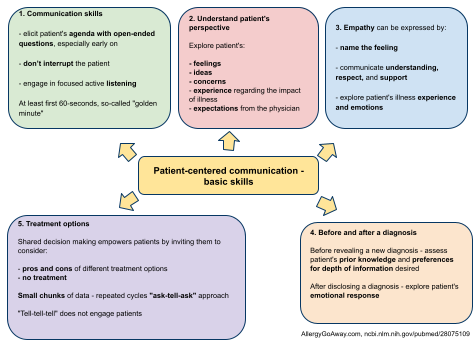Home
Archive for
January 2017
Patient-centered communication: what are the basic skills?
Communication skills needed for patient-centered care include:
- eliciting the patient's agenda with open-ended questions, especially early on
- not interrupting the patient
- engaging in focused active listening
Practice this at least in the first 60-seconds, the so-called "golden minute".
Understand patient's perspective
Understanding the patient's perspective of the illness and expressing empathy are key features of patient-centered communication.
Understanding the patient's perspective entails exploring the patient's:
- feelings
- ideas
- concerns
- experience regarding the impact of the illness
- expectations from the physician

Patient-centered communication - basic skills (click here to enlarge the image).
Empathy
Empathy can be expressed by:
- naming the feeling
- communicating understanding, respect, and support
- exploring the patient's illness experience and emotions
Before and after a diagnosis
Before revealing a new diagnosis, the patient's prior knowledge and preferences for the depth of information desired should be assessed.
After disclosing a diagnosis, physicians should explore the patient's emotional response.
Treatment options
Shared decision making empowers patients by inviting them to consider:
- pros and cons of different treatment options
- no treatment
Instead of overwhelming the patient with medical information, small chunks of data should be provided using repeated cycles of the "ask-tell-ask" approach. Using "tell-tell-tell" does not engage patients.
Example:
1. Ask permission to start a conversation
3. Ask what the patient thinks about their health
4. Ask questions to find out what the patient already knows
5. Tell the patient information in a way that is easy to understand
6. Gauge the patient’s understanding by asking questions after you tell
What Is “Ask, Tell, Ask”? video:
References:
Patient-Centered Communication: Basic Skills. Hashim MJ. Am Fam Physician. 2017 Jan 1;95(1):29-34.
https://www.ncbi.nlm.nih.gov/pubmed/28075109
The 10 Building Blocks of Primary Care - “Ask Tell Ask” Sample Curriculum - UCSF
Ask-Tell-Ask: Simple Technique Can Help Hospitalists Communicate Difficult Messages http://buff.ly/2jeNVIN
- eliciting the patient's agenda with open-ended questions, especially early on
- not interrupting the patient
- engaging in focused active listening
Practice this at least in the first 60-seconds, the so-called "golden minute".
Understand patient's perspective
Understanding the patient's perspective of the illness and expressing empathy are key features of patient-centered communication.
Understanding the patient's perspective entails exploring the patient's:
- feelings
- ideas
- concerns
- experience regarding the impact of the illness
- expectations from the physician
Patient-centered communication - basic skills (click here to enlarge the image).
Empathy
Empathy can be expressed by:
- naming the feeling
- communicating understanding, respect, and support
- exploring the patient's illness experience and emotions
Before and after a diagnosis
Before revealing a new diagnosis, the patient's prior knowledge and preferences for the depth of information desired should be assessed.
After disclosing a diagnosis, physicians should explore the patient's emotional response.
Treatment options
Shared decision making empowers patients by inviting them to consider:
- pros and cons of different treatment options
- no treatment
Instead of overwhelming the patient with medical information, small chunks of data should be provided using repeated cycles of the "ask-tell-ask" approach. Using "tell-tell-tell" does not engage patients.
Example:
1. Ask permission to start a conversation
3. Ask what the patient thinks about their health
4. Ask questions to find out what the patient already knows
5. Tell the patient information in a way that is easy to understand
6. Gauge the patient’s understanding by asking questions after you tell
What Is “Ask, Tell, Ask”? video:
References:
Patient-Centered Communication: Basic Skills. Hashim MJ. Am Fam Physician. 2017 Jan 1;95(1):29-34.
https://www.ncbi.nlm.nih.gov/pubmed/28075109
The 10 Building Blocks of Primary Care - “Ask Tell Ask” Sample Curriculum - UCSF
Ask-Tell-Ask: Simple Technique Can Help Hospitalists Communicate Difficult Messages http://buff.ly/2jeNVIN
Percentage of U.S. residents with up-to-date screening for colorectal cancer remains at 60% - what options, other than colonoscopy, do we have?
From the NEJM:
The percentage of U.S. residents with up-to-date screening for colorectal cancer has not increased appreciably since 2010 and remains at approximately 60%. To achieve the highest level of adherence to colorectal cancer screening, it may be best to provide participants a choice, because the “best” strategy is the one that they will adhere to consistently.
The NEJM reviews all the options in this table:
http://blogs.nejm.org/now/wp-content/uploads/sites/6/2017/01/nejmcp1512286_t2.jpeg
Full article is here:
Screening for Colorectal Neoplasia - Now@NEJM http://buff.ly/2ikfKA0
The percentage of U.S. residents with up-to-date screening for colorectal cancer has not increased appreciably since 2010 and remains at approximately 60%. To achieve the highest level of adherence to colorectal cancer screening, it may be best to provide participants a choice, because the “best” strategy is the one that they will adhere to consistently.
The NEJM reviews all the options in this table:
http://blogs.nejm.org/now/wp-content/uploads/sites/6/2017/01/nejmcp1512286_t2.jpeg
Full article is here:
Screening for Colorectal Neoplasia - Now@NEJM http://buff.ly/2ikfKA0
Physician ratings at Cleveland Clinic (video)
The CEO and the Chief Experience Officer explain the rationale behind the physician ratings at Cleveland Clinic:
Disclaimer: I am an allergist at Cleveland Clinic Florida.
Disclaimer: I am an allergist at Cleveland Clinic Florida.
Problem solver
From Italian: Pedro and Domenico jump, but Oreste thinks about it a bit... and finds another solution.
#donkey #problemsolving
Related:
This little video even made it to Daily Mail: Donkey shows off his brains by using his TEETH to remove a fence http://buff.ly/2iYmpzn
#donkey #problemsolving
Related:
This little video even made it to Daily Mail: Donkey shows off his brains by using his TEETH to remove a fence http://buff.ly/2iYmpzn
Subscribe to:
Comments
(
Atom
)



